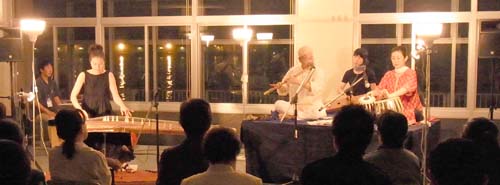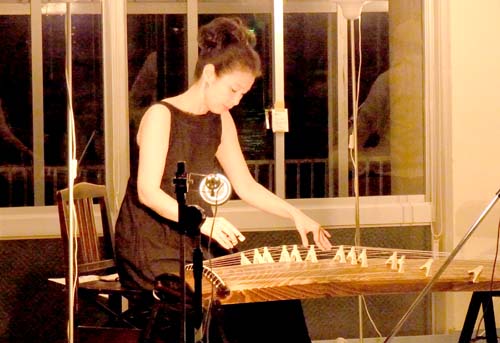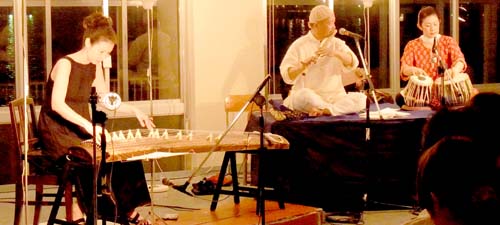2010年9月28日
9/18 Hiros and Friends at Club Q2

Sometimes it's hard to tell where one thing ends and another begins. Random conversations occur and we are tempted to think of them as isolated and discrete events. This isn't always the case.
One evening in spring, I was leaving Studio Y3 walking to Sannomiya Station. It happened that Hiros was leaving at the same time. We went out together into the night. What followed was one of those rather rare conversations.
We quickly passed through the customary pleasantries and onto a subject Douglas Adams might have called, "life, the universe and everything" This included a few brief remarks about years Hiros spent living and studying traditional music at an international program in India along the Ganges river. During that conversation, he never intimated that there was anything more to say on the subject. However, I later learned that what he had to say that evening about the music he performs was just the tip of the iceberg.
A couple of years ago, Hiros and Shimoda Nobuhisa san (Director of C.A.P.) had a conversation about the state of Japanese Traditional Music in contemporary Japan. During that conversation, Hiros said that while in India it was common for the international students (of which he was one) to gather together at the end of the day and discuss music. Typically, they might have talked about the traditional music of their respective home countries. Hiros felt that he was dissatisfied with what he knew about Traditional Japanese Music. Furthermore, upon reflection, he realized that many Japanese had no informed appreciation of their Traditional Music.
Since the Meiji Restoration, European education models replaced traditional Japanese education. Music education in Public schools too underwent the same transformation, and with this, a general knowledge of Japanese musical culture faded. Hiros wanted to change this and to go further. So the two men, Hiros and Shimoda san, decided to create a concert series that presented Traditional Music for the public, but they wisely recognized that without an energetic context, such performances might seem rather dull for newer audiences. So they have encouraged the participation of diverse musical talents. These have been musicians who not only appreciate traditional musical culture, but also recognize that to thrive and grow a fusion between the old and the new must be lively and ongoing. The concert series invites the participation not only of musicians, but also of composers.
So on the evening of September 18th, I stepped off the Port Liner at Port Terminal Station and followed the signs down the stairs to Studio Q2 (one of two studios operated by C.A.P.). It was twilight and the early darkness hovered outside the wall of glass that gave a nearly uninterrupted view of the harbor. From across the water, one could see the distant lights of buildings and cars as well as the occasional airplane and passing ships.
I have to confess that the lighting, the view and the intimate setting leave one with a sense that something exceptional is about to begin and if that is your sense, you will not be disappointed. The format of these concerts is simple. An introduction of the music (it used to be a lecture) followed by the performance. Rather than having a stuffy, formal sense (as could easily happen) these intros are skillful, lighthearted and helpful. I think this is largely due to Hiros-san's thorough command of his subject and the grace of his unvarnished personality.
This was the second of six concerts in this series that I had attended (see the 9/18 entry at: https://www.cap-kobe.com/club_q2/ ). The first was a year ago, almost to the day. On that occasion, Hiros-san presented with a chorus of monks called the Shichiseikai performing music known as Shomyo. Also accompanying him that evening was Tanaka Riko-san playing tabla. On that evening, I learned not to expect the ordinary. I remember leaving the venue and saying to my wife and daughter that I had never experienced anything like it. This evening was no different.
The first piece was a composition for flute and koto. The koto was played by Fukuhara Sawako-san, a world renown koto musician. It was a beautiful selection. As the first notes rose into the room, they seemed to change the sense of where we were. It was a kind of transformation. What I noticed was the way everyone in the room became captive to the sound. It also became immediately conspicuous that Sawako-san was very precise and strong.

The second selection was equally strong. With that, it became obvious that the choices made around the selection of works was clear and forceful. These concerts are not soft surveys of a musical genre: They are rigorous and energetic. Through the choices I felt we were being led toward an understanding of the richness and flexibility of this music.
The following four pieces carried this theme of richness and flexibility forward and added to the ensemble the Tabla played by Riko-san as well as the electric and acoustic Tabula played by Ishio Maho-san.

It's important to say that several times throughout the concert, I had the feeling of witnessing
one of those great performances of the early Jazz era. The room was full of admiration and affection for a vital and sometimes breathtaking sound.
The evening ended the way you might expect, an enthusiastic audience gathering around to express their appreciation for a beautiful evening. It was difficult to leave without saying something to these wonderful artists.
This concert series is a great contribution to the cultural life of Kobe. To write about it, I think, demands that I give our readers a little more depth. So I will be writing about this again. With luck, the conversation I thought was random and isolated will be only the beginning.




 Paul Venet
Paul Venet
